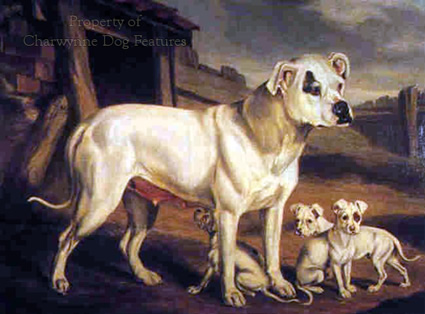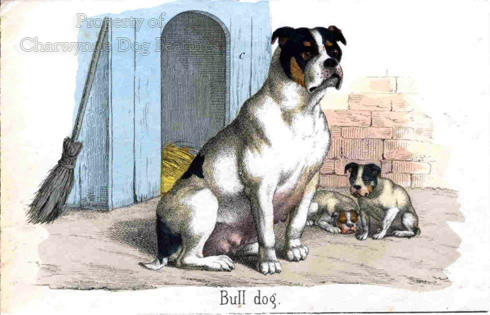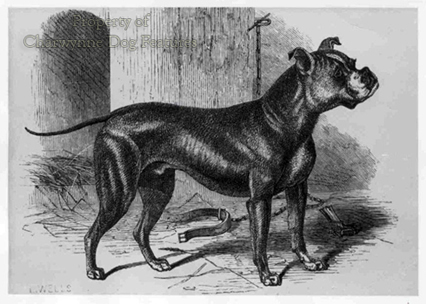189 BRINGING BACK THE REAL BULLDOG
BRINGING BACK THE REAL BULLDOG
by David Hancock

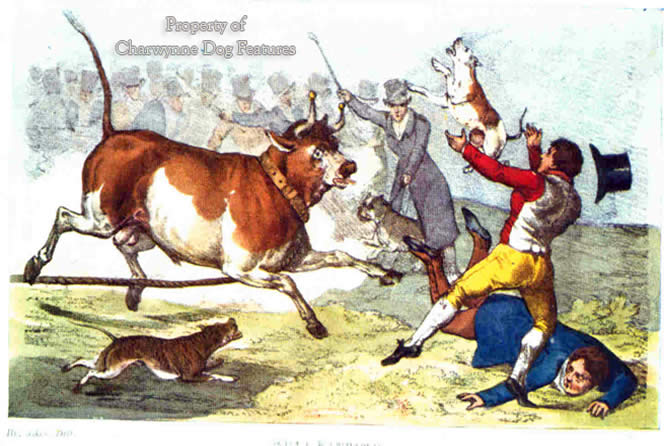

The British have over the years created more breeds of dog than any other nation. But of these breeds, one above all has been singled out, especially in times of international crisis, to symbolise our national characteristics: the bulldog. Long misused by man in such barbaric activities as bear and bull-baiting, the bulldog has come to be seen as epitomising the tenacity, stoicism and pugnacity desired in British stock. But in this breed, as so often with pedigree breeds of dog, the wish to perpetuate strong breed characteristics has led to harmful exaggeration. The desire for a pugnacious look which so typifies the breed has led misguided fanciers in the past to outcross with pugs to shorten the muzzle. The seeking for an indomitable, 'no surrender' stance in the breed has led to poor front quarters, with specimens in Victorian times displaying all kinds of quite dreadful structural faults. The pedigree bulldog was turned into a caricature of itself. It is only fair however to say that, in the last twenty years, bulldog fanciers have taken steps to make the breed sounder, with tighter mouths for example. But it is also fair, I believe, to say that the pedigree bulldog still lacks the mobility, muzzle-length, leg-length and health and vigour of its prototypal ancestors.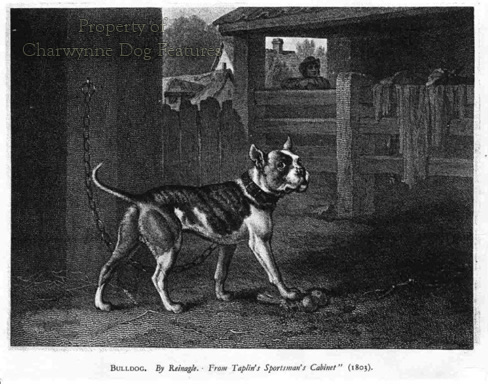
To survive in the bullring, a bulldog had to be lightning fast; agile and athletic,as well as fearless and tenacious. We cannot claim to be breeding real bulldogs unless the breed is still physically able to (although thankfully never asked to ) carry out its original function. Against this background, it is pleasing to come across a bulldog breeder in Canada, using stock handed down from migrating ancestors, who is perpetuating the breed much more in its classic mould than showring fanciers in this or any other country. Bulldog devotees here would no doubt claim that a "Kennel Club" bulldog is the real bulldog. To them I would say: "Look at the early paintings, even the early photographs of the breed and you will soon see that you have lost your way, in your endeavours to strive for those breed points which, somewhat strangely, judges consider as essential." Lolly Wilkinson of Vancouver Island, British Columbia, tells me that her dogs weigh around 75lbs for a male and 50lbs for a female, with the dogs about 19" at the shoulder and the bitches around 17".
This is rather different from the current KC standard for the breed which puts dogs at 55lbs, with no height stipulated. The 1865 description of a bulldog by 'Philo-Kuon', often quoted by breed enthusiasts, lays down a bracket of 20-60lbsweight. But at the end of the 18th century, with bullbaiting still in vogue, taller and heavier dogs were favoured, as the illustrations of the breed at that time indicate. The painting of a pair of bulldogs 'Crib and Rosa' by Abraham Cooper in 1817 inspired many bulldog breeders in the nineteenth century, with 'Rosa' being considered to "approach perfection in shape, make and size of the ideal type of the bulldog", as the early standard put it. But in 1894 the committee of the bulldog club deleted this sentence. Since then the pedigree bulldog has lost the length of leg, the athletic build and the overall symmetry of 'Rosa'. Writing in his highly respected "The Bulldog - a Monograph" of 1899, Edgar Farman referred to this deletion with these words:"By the old school this act on the part of the Bulldog Club was considered little short of vandalism...Certain it is that fashion has decreed for the moment that the 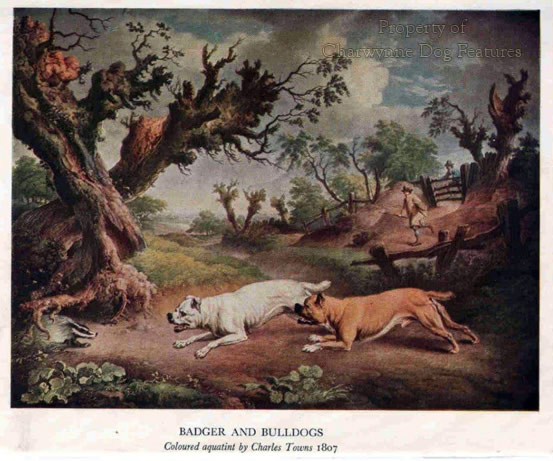 English bulldog should not be what Rosa was"...Since that decision, our famous bulldog, considered by many to be our national mascot, has become in many ways a squat, wheezing, low-slung, unathletic distortion of its true form, unable to give birth naturally and handicapped by respiratory problems.But Lolly Wilkinson in Canada has a ten year old dog which can run, swim and frolic endlessly; her bitches whelp large litters in a few hours without veterinary assistance. She will have nothing to do with Kennel Clubs or breed clubs and quite admirably breeds principally for health and temperament.
English bulldog should not be what Rosa was"...Since that decision, our famous bulldog, considered by many to be our national mascot, has become in many ways a squat, wheezing, low-slung, unathletic distortion of its true form, unable to give birth naturally and handicapped by respiratory problems.But Lolly Wilkinson in Canada has a ten year old dog which can run, swim and frolic endlessly; her bitches whelp large litters in a few hours without veterinary assistance. She will have nothing to do with Kennel Clubs or breed clubs and quite admirably breeds principally for health and temperament.
If only some of our other native breeds had such enlightened patronage. It is not unusual for a breed club to change a breed standard, normally to suit the dominent club members at that time. In this way the description of the coat colour in golden retrievers was amended to embrace the biscuit-coloured specimens being bred by some influential fanciers. As a direct result, the true red-gold coat colour in this handsome breed is now rarely seen in the showring but, significantly, still features in the working dogs. The weight of the Clumber spaniel has all but doubled in the last hundred years, to suit the leading breeders (who do not work their dogs) with heavier stock. The Kennel Club, established to promote the best interests of dogs, stands aloof from such ill-founded changes, stating naively that breed clubs must have autonomy. I find that irresponsible and unrealistic, especially where our native breeds are concerned. So who will save our celebrated bulldog and restore it to the healthier, more athletic and truer to type model provided by the much admired Rosa nearly two hundred years ago ? Certainly not the bulldog breed clubs or the Kennel Club. It will demand an English equivalent of Canada's Lolly Wilkinson.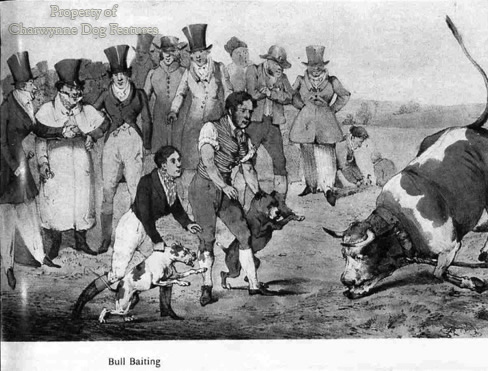
It is encouraging to learn of small groups of enthusiasts trying to preserve a working Bedlington terrier, to re-create the Lucas terrier and to restore genuine type to the Sealyham. But our bulldog is an even more important part of our canine heritage, appealing to every real patriot and deserving, of all our native breeds, to be perpetuated in its true historic mould for those who come after us. This situation is not helped by the strange preference in this country for German dogs: Dobermanns, Rottweilers, Boxers, Dachshunds, Weimaraners, short and wire-haired pointers, shepherd dogs, Schnauzers, Munsterlanders and Hovawarts, which has led to the demise of so many of our native breeds. Roughly 7,000 new registrations for Boxers, the German equivalent of our bulldog, are made with the KC each year, against 1,500 for the bulldog. Before the 1930's the Boxer was virtually unknown in this country.
Writing on the bulldog before the first world war, Robert Leighton, the leading dog writer of that time, stated that: "It must be acknowledged that there are many strains of this breed which are constitutionally unsound...Excessive shortness of face is not natural...The specimens alive in 1817 as seen in prints of that period, were not so cloddy as those met with at the present day". Eighty years later the bulldog is even "cloddier" and less like its ancestors. Another much respected dog writer, Arthur Croxton-Smith, writing between the wars, stated that : "Few breeds have undergone more changes or departed more markedly from the original than the bulldog". We now need a bulldog breeder with a moral motivation, independence of character and desire for authenticity to show the way back to other bulldog fanciers. A love of dogs alone could lead that breeder to produce a healthier more mobile bulldog; a love of country in addition could lead to our national canine symbol being restored to its true type. Come home Lolly Wilkinson !
